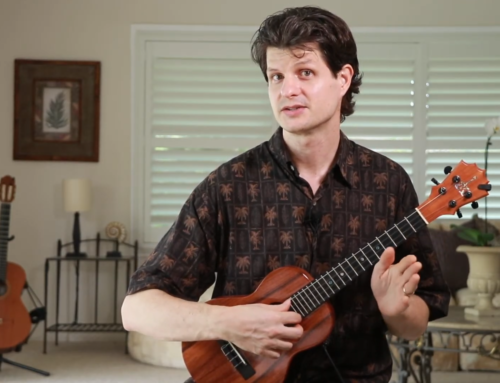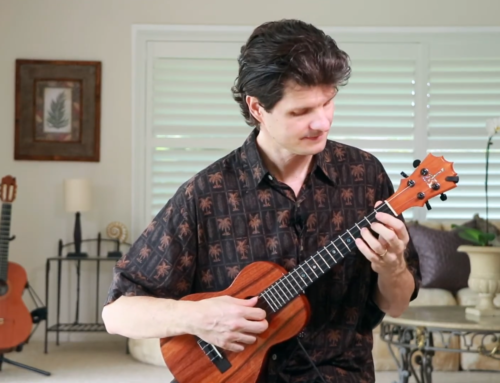Harmonizing a major scale with three note chords or triads creates a wonderful sequence of chords that can be used to play a wide range of music. There is a basic formula for this sequence, which is often described using Roman numerals with an upper case numeral being a major chord and a lower case numeral being a minor chord. Here is the sequence for a harmonized major scale:
- I ii iii IV V vi vi(diminished)
Notice how the 7th chord in the sequence is diminished. All the others are either major or minor. The I, IV and V chords are major. The ii, iii, and vi chords are minor.
In the key of C this would translate to:
- C Dm Em F G Am Bdim
It is common to substitute a V7 chord or G7 for the B diminished chord. In the video lesson here we will explore these chords in 1st position. Once you are comfortable with them and have the progression memorized you will begin to see how chord progressions work. A common chord progression is I vii IV V for example. In the key of C this would be C Am F G. If you already know some chord progressions in the key of C, try to analyze them to understand how this system works. If you find a chord in a song that is not part of this harmonized scale it is likely because accidentals or notes outside of the key of C were used for a moment. This can create variations on the sequence. A few common alterations of chords are minor IV chords (Fm in the key of C) or VI7 II7 V7 I patterns (A7, D7, G7, C) which is common in both Swing and Hawaiian music.




Very nice and clear explanation, Jeff. It would be easy for anyone to follow.
great tutorial on harmonizing the major scale
would the same idea apply to keys in the minor scale?
Hi Gloria,
Yes the same idea applies to the minor scale although because it is a minor scale it would be like this…
i ii (diminished) III iv v VI VII
If you use the relative minor of C Major (which is A minor) then you get to use the same notes that are in the C Major scale The note A would be the tonic or root note and A minor the root chord.
Hope that’s helpful : )
Thank you,, well explained, is I vii IV V a typo? If I understand correctly A min would be vi not vii
Yes Darren–that is correct about the vi chord being Am in the key of C.
this is great! thank you.
Nice touch adding the song illustration. Makes the theory come to life!
Very simply put, just have to get everything in sinc
Aloha Jeff,
Great presentation on the music theory of a major scale.
I love the sound of the Hawaiian vamp, sometimes shown as II7-V7-I; for example D7-G7-C in the key of C. I try to explain to students that when you play the D7 in the C Vamp you are really modulating to G for just those two chords. This explains how a D chord, which should be minor in C is played as a Major chord. I sometimes note this as V7/V-V7-I. Here this weird notation “V/V” is read as “V of V” to show this modulation. Sometimes I use the Circle of 5ths to help explain this, but that’s another lesson. Using the Circle of 5ths can also make it easy to figure out the chords for the Hawaiian vamp in other keys!
I look forward to more lessons with you in the future,
Peter
Really enjoyed this tutorial .. it brought some life to my layed back casual 5 min play scenarios. What would be awesome would be a tutorial on the strumming you used for the Over the Rainbow song. I’ve never heard the song played like this. Thank you again for your clear relaxed style of instruction. Colleen
Very interested in your lessons. I play a baritone ukulele,anywhere I can fit in?
Hi Danny, If you follow the fingering here on a baritone it would be in the key of G: G Am Bm C D Em F#dim